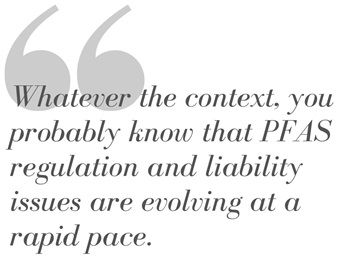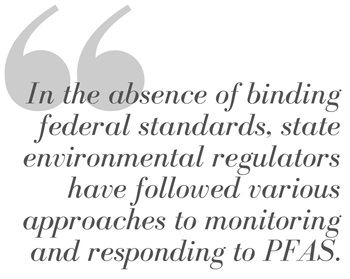In May 2021, the federal Agency for Toxic Substances and Disease Registry (ATSDR) finalized a report containing toxicological profiles and associated Minimal Risk Levels (MRLs) for several perfluoroalkyls (PFAS), a family of chemicals marked by their persistence in the environment, bioaccumulation in human and animal tissue, and toxicity at extremely low levels (in the parts per trillion).1 You may have seen PFAS flagged as contaminants of concern at sites across the country or seen the film "Dark Waters" about PFAS toxic tort litigation. Whatever the context, you probably know that PFAS regulation and liability issues are evolving at a rapid pace. So what does ATSDR's new report mean going forward?

Bottom line: this report sets the stage for what is likely to be a contentious battle regarding PFAS clean-up levels in the years ahead. Although the general potential for harmful effects from PFAS was identified several decades ago, definitive guidance on valid screening and cleanup levels for specific PFAS chemicals has lagged further behind as the science around PFAS toxicity and testing methodologies has developed. Prior to the ATSDR report, the U.S. Environmental Protection Agency (U.S. E.P.A.) had set a non-binding health advisory level of 70 parts per trillion (ppt) combined for perfluorooctanoic acid (PFOA) and perfluorooctane sulfonic acid (PFOS) for lifetime chronic exposure and also issued a December 2019 interim recommendation for a 40 ppt combined PFOA/PFOS screening level for federal cleanup programs (leaving 70 ppt as a preliminary remediation goal). U.S. E.P.A. has yet to designate any PFAS chemical as a hazardous substance for purposes of the Comprehensive Environmental Response, Compensation, and Liability Act (CERCLA) or a hazardous waste for purposes of Resource Conservation and Recovery Act (RCRA).2
In the absence of binding federal standards, state environmental regulators have followed various approaches to monitoring and responding to PFAS. Many states have conducted testing of major drinking water sources for PFAS, either on their own initiative or under U.S. E.P.A.'s Unregulated Contaminant Monitoring Regulation 3 requiring sampling under the Safe Drinking Water Act, but sampling of private wells and smaller non-community systems has been sporadic. Some states have developed screening and action levels lower than U.S. E.P.A.'s, while others have relied on the federal 70 ppt health advisory level as a credible number to guide agency action. Overall, this has created a patchwork of information and regulation across U.S. jurisdictions.

ATSDR's new report, developed as part of its statutory role in researching health effects of toxic substances under CERCLA section 104(i), 42 U.S.C. § 9604(i), now offers new estimated MRLs for oral ingestion of PFOA, PFOS, perfluorohexane sulfonic acid (PFHxS), and perfluorononanoic acid (PFNA). These recommendations are intended to serve as screening tools rather than cleanup standards.3 ATSDR set reference doses of: 3x10-6 mg/kg/day for PFOA; 2x10-6 mg/kg/day for PFOS; 2x10-5 mg/kg/day for PFHxS; and 3x10-6 mg/kg/day for PFNA. The reference doses for PFOA and PFOS are, respectively, 7 and 10 times more stringent than the reference doses used to calculate the 2016 health advisory level of 70 ppt, while U.S. E.P.A. had not set any reference dose for PFHxS and PFNA.
Given the unsettled status of PFAS regulation to date, these MRLs have the potential to spur debate on all ends of the spectrum. In a state like Michigan, which has developed its own drinking water standards for PFAS chemicals that are in some cases based on reference doses even lower than those in the ATSDR report,4 the question becomes whether the state will adopt differing federal values that it may see as less stringent. Conversely, a state like Ohio that has utilized the 70 ppt health advisory level will need to consider how to respond to this new research. A range of stakeholders will have to determine how to evaluate existing drinking water testing results in light of the ATSDR report. And U.S. E.P.A. itself will inevitably incorporate the ATSDR analysis in its ongoing consideration of whether to designate any PFAS chemicals as hazardous under CERCLA and/or RCRA and whether to set maximum contaminant levels for PFAS in drinking water. In all cases, regulators will continue to face choices around how to apply the growing universe of PFAS research as experts continue to refine methodologies for sampling, analyzing fate and transport, source identification through available "fingerprinting" approaches, and treatment.
Dickinson Wright has been on the vanguard of these issues in Michigan, a hotspot for PFAS regulatory action, and stands ready to assist clients in this arena going forward.
Footnotes
1. ATSDR, Toxicological Profile for Perfluoroalkyls (May 2021) ("ATSDR PFAS Report"), available at https://wwwn.cdc.gov/TSP/ToxProfiles/ToxProfiles.aspx?id=1117&tid=237.
2. U.S. EPA has taken other actions, including adding over 150 PFAS compounds to the Toxic Release Inventory reporting requirements for reporting years 2020 and 2021. U.S. EPA, Chemicals Added to the Toxics Release Inventory Pursuant to Section 7321 of the National Defense Authorization Act, https://www.epa.gov/sites/production/files/2021-01/documents/tri_non-cbi_pfas_list_1_8_2021_final.pdf.
3. ATSDR PFAS Report at 15.
4. Michigan Science Advisory Workgroup, Health-Based Drinking Water Value Recommendations for PFAS in Michigan (June 27, 2019), https://www.michigan.gov/documents/pfasresponse/Health-Based_Drinking_Water_Value_Recommendations_for_PFAS_in_Michigan_Report_659258_7.pdf (PFHxS reference dose of 9.7 x 10-6 mg/kg/day).
The content of this article is intended to provide a general guide to the subject matter. Specialist advice should be sought about your specific circumstances.
